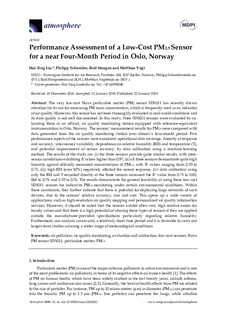| dc.description.abstract | The very low-cost Nova particulate matter (PM) sensor SDS011 has recently drawn attention for its use for measuring PM mass concentration, which is frequently used as an indicator of air quality. However, this sensor has not been thoroughly evaluated in real-world conditions and its data quality is not well documented. In this study, three SDS011 sensors were evaluated by co-locating them at an official, air quality monitoring station equipped with reference-equivalent instrumentation in Oslo, Norway. The sensors’ measurement results for PM2.5 were compared with data generated from the air quality monitoring station over almost a four-month period. Five performance aspects of the sensors were examined: operational data coverage, linearity of response and accuracy, inter-sensor variability, dependence on relative humidity (RH) and temperature (T), and potential improvement of sensor accuracy, by data calibration using a machine-learning method. The results of the study are: (i) the three sensors provide quite similar results, with inter-sensor correlations exhibiting R values higher than 0.97; (ii) all three sensors demonstrate quite high linearity against officially measured concentrations of PM2.5, with R2 values ranging from 0.55 to 0.71; (iii) high RH (over 80%) negatively affected the sensor response; (iv) data calibration using only the RH and T recorded directly at the three sensors increased the R2 value from 0.71 to 0.80, 068 to 0.79, and 0.55 to 0.76. The results demonstrate the general feasibility of using these low cost SDS011 sensors for indicative PM2.5 monitoring under certain environmental conditions. Within these constraints, they further indicate that there is potential for deploying large networks of such devices, due to the sensors’ relative accuracy, size and cost. This opens up a wide variety of applications, such as high-resolution air quality mapping and personalized air quality information services. However, it should be noted that the sensors exhibit often very high relative errors for hourly values and that there is a high potential of abusing these types of sensors if they are applied outside the manufacturer-provided specifications particularly regarding relative humidity. Furthermore, our analysis covers only a relatively short time period and it is desirable to carry out longer-term studies covering a wider range of meteorological conditions | nb_NO |

